 After many years of trotting around town with pockets stuffed full of a Palm PDA and a mobile phone, we decide that an all-in-one PDA/smartphone combo would be the best way to reduce our ostentatious trouser bulge.
After many years of trotting around town with pockets stuffed full of a Palm PDA and a mobile phone, we decide that an all-in-one PDA/smartphone combo would be the best way to reduce our ostentatious trouser bulge.
Our first instinct was to go for the Palm Treo 650, a fabulous looking device with a big screen, great ergonomics and a top-notch thumb board, but after we realised that Palm’s promised Wi-Fi card had turned into vapourware, we were forced to look to the Dark Side and switch to a Microsoft solution.
After much chin-stroking and spec sheet sniffing, we settled on the i-mate JAM (aka T-Mobile MDA Compact), a feature-packed little fella running Windows Mobile 2003.
Measuring just 5.8cm wide by 10.8cm deep by 1.81cm high, the handset is considerably smaller than o2’s chunky XDAII, offering similar proportions to Orange’s SPV C500 and Sony Ericsson’s P910.
Attractively finished in a brushed silver finish with a ribbed black side section, the JAM is of a fairly minimalist design, with call and end buttons sitting beneath the 2.8in TFT transflective screen (240 x 320 pixels), plus three buttons and a rocker controller for accessing the built-in calendar, contacts and other applications.
If anything, the case is a little too sleek for its own good, with its shiny finish making it a bugger to keep a grip on at times. We recommend buying a ‘rubberised’ case like those from proporta.com for safety.
 The left hand side sports the camera button, volume control and voice memo switch, none of which are particularly well placed (it’s all too easy to fire off the voice memo/camera switched when turning the handset on).
The left hand side sports the camera button, volume control and voice memo switch, none of which are particularly well placed (it’s all too easy to fire off the voice memo/camera switched when turning the handset on).
On the opposite side can be found the on/off switch and slightly fiddly stylus silo, while the 1.3 megapixel camera lens and small mirror can be found on the back.
In use, the tri-band GSM/GPRS JAM 416MHz device seemed nippy enough, with the Intel XScale PXA272 processor providing enough muscle for any tasks we threw at it.
The handset comes with a rather stingy 64MB of RAM installed (57.41MB available to the user), with 7.6MB of ROM also available for backing up data.
Bluetooth support is built in, and there’s a SD card slot for adding extra storage capacity or for fitting a Wi-Fi card (our SanDisk Wi-Fi card worked fine on the JAM).
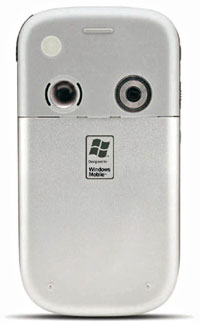 Performance
Performance
After six months with the phone, we’re still generally pleased with its performance but there are some niggles.
First off, the built in camera is absolutely rubbish. Despite its 1.3 megapixel credentials, we’ve had better results off much lower spec’d camera phones and you certainly won’t be printing out too many snaps captured on the thing.
Voice quality isn’t great and the sound quality fell considerably behind regular mobile phones, with the speakerphone being somewhat under-powered. MP3 playback quality was good though.
Although the on-screen keyboard comes with several intuitive interfaces, we’d still prefer a hardware keyboard, especially when we’re out and about – in fact, the awkwardness of inputting text onscreen via a stylus means that we may well be considering the new Treo 700w when we upgrade phones.
Battery life proved excellent throughout our test period, providing enough juice to keep the MP3 going for around five hours.
In general use, we found it prudent to charge the phone daily using the provided mini-USB sync/charge connector – a handy way of charging the phone from a notebook.
At £359 without a phone contract, the i-mate JAM isn’t the greatest value, but with a slew of much cheaper contract deals available, we can recommend it as an excellent, albeit not perfect, all round, all-in-one PDA/smartphone.
RATING: 85%
 Despite being billed as the “Killer-Sound Phone” by makers Pantech & Curitel, we’re happy to report that the PT-L1900 doesn’t emit a murderous noise beam, but is in fact a top notch music phone.
Despite being billed as the “Killer-Sound Phone” by makers Pantech & Curitel, we’re happy to report that the PT-L1900 doesn’t emit a murderous noise beam, but is in fact a top notch music phone.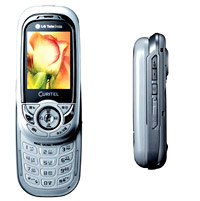 Back to the phone, the mid-size device (102X48X25.7mm) is dominated by a large, two inch, 240X320 pixels (QVGA), 262k colour TFT LCD display screen, with a slide out keyboard for phone functions.
Back to the phone, the mid-size device (102X48X25.7mm) is dominated by a large, two inch, 240X320 pixels (QVGA), 262k colour TFT LCD display screen, with a slide out keyboard for phone functions. The makers claim up to 190 hours of standby time and up to 3½ hours of talk time.
The makers claim up to 190 hours of standby time and up to 3½ hours of talk time.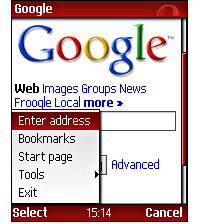 Opera Software have announced the worldwide release of
Opera Software have announced the worldwide release of 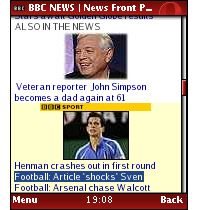 As a result of the compression technology, users can surf the Web faster – and those paying for their data traffic can dramatically reduce their bandwidth costs.
As a result of the compression technology, users can surf the Web faster – and those paying for their data traffic can dramatically reduce their bandwidth costs.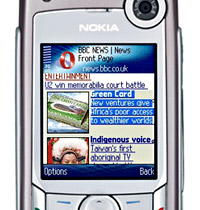 “With Opera Mini most people can start surfing the Web with the mobile phone they have today,” purred Jon S. von Tetzchner, CEO, Opera Software.
“With Opera Mini most people can start surfing the Web with the mobile phone they have today,” purred Jon S. von Tetzchner, CEO, Opera Software. Opera Mini can be freely downloaded by pointing your phone’s WAP browser in the direction of
Opera Mini can be freely downloaded by pointing your phone’s WAP browser in the direction of  Mobile operator 3 has launched an innovative service that, for the first time, pays customers to receive calls and texts.
Mobile operator 3 has launched an innovative service that, for the first time, pays customers to receive calls and texts.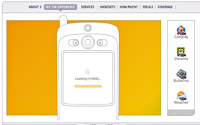 Designed to boost usage of data services, 3 also hopes that the cash-back scheme will prove attractive to new punters and tempt customers from other networks to switch.
Designed to boost usage of data services, 3 also hopes that the cash-back scheme will prove attractive to new punters and tempt customers from other networks to switch. The WePay top-ups come as all-cash vouchers available in £10, £15 and £20 denominations, with no expiry date. However, the WePay cash credits are only valid for 30 days.
The WePay top-ups come as all-cash vouchers available in £10, £15 and £20 denominations, with no expiry date. However, the WePay cash credits are only valid for 30 days.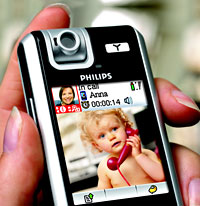 It’s been a long time coming, but Dutch enormo-corp Philips are looking set to finally roll out their innovative Wi-Fi-enabled VoIP telephone, the VP-5500.
It’s been a long time coming, but Dutch enormo-corp Philips are looking set to finally roll out their innovative Wi-Fi-enabled VoIP telephone, the VP-5500.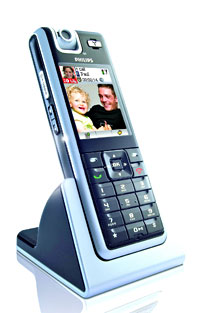 Announced way back in Sept 2005, the VoIP phone comes with a VGA camera that rotates up to 240 degrees, letting users check out their look on the built-in, high-resolution LCD display before committing a potential videocall fashion catastrophe.
Announced way back in Sept 2005, the VoIP phone comes with a VGA camera that rotates up to 240 degrees, letting users check out their look on the built-in, high-resolution LCD display before committing a potential videocall fashion catastrophe.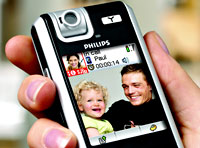 Built around established standards-based technologies like Wi-Fi and Linux, the VP5500 can be upgraded wirelessly, opening the door to future upgrades – giving operators the chance to add value-added services as the becmoe available.
Built around established standards-based technologies like Wi-Fi and Linux, the VP5500 can be upgraded wirelessly, opening the door to future upgrades – giving operators the chance to add value-added services as the becmoe available. To be honest, we’re still a little unsure about video calling.
To be honest, we’re still a little unsure about video calling.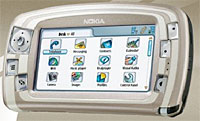 Two recent studies into mobile TV on 3G mobile phones have managed to produce rather inconclusive results concerning the willingness of the great British public to use the service and how much they’d be prepared to pay for it.
Two recent studies into mobile TV on 3G mobile phones have managed to produce rather inconclusive results concerning the willingness of the great British public to use the service and how much they’d be prepared to pay for it.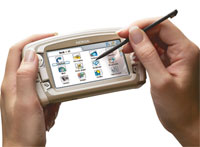 The feedback seemed back-slappingly reassuring, with 83 per cent of the triallists “satisfied” with the service, and 76 per cent indicating they’d be keen to take up the service within 12 months.
The feedback seemed back-slappingly reassuring, with 83 per cent of the triallists “satisfied” with the service, and 76 per cent indicating they’d be keen to take up the service within 12 months.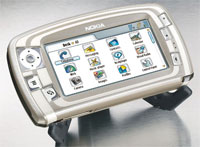 “This trial is further illustration that we are moving from a verbal only to a verbal and visual world in mobile communications,” said David Williams, O2’s technology chief.
“This trial is further illustration that we are moving from a verbal only to a verbal and visual world in mobile communications,” said David Williams, O2’s technology chief. In a feast of digital convergence, Pantech & Curitel have announced the launch of their new multimedia-tastic PT-S160 phone.
In a feast of digital convergence, Pantech & Curitel have announced the launch of their new multimedia-tastic PT-S160 phone.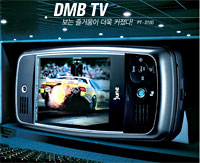 The PT-S160 doubles up as a PMP (Portable Multimedia Player) and a satellite DMB receiver, with a sliding design only showing keys for DMB functions when closed.
The PT-S160 doubles up as a PMP (Portable Multimedia Player) and a satellite DMB receiver, with a sliding design only showing keys for DMB functions when closed.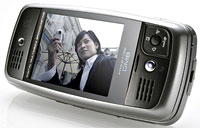 The screen can be switched between landscape and portrait formats.
The screen can be switched between landscape and portrait formats. The makers claim a talk time of 300 minutes and a hefty standby time of 300 hours (although we’ve no idea how long you’ll get when watching TV).
The makers claim a talk time of 300 minutes and a hefty standby time of 300 hours (although we’ve no idea how long you’ll get when watching TV).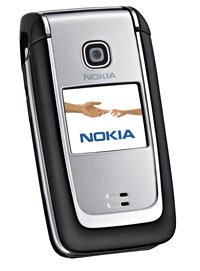 Nokia has shunted out a new addition to their mid-range mobile portfolio with the new Nokia 6125 clamshell phone, offering stereo audio streaming over Bluetooth and FM Radio.
Nokia has shunted out a new addition to their mid-range mobile portfolio with the new Nokia 6125 clamshell phone, offering stereo audio streaming over Bluetooth and FM Radio.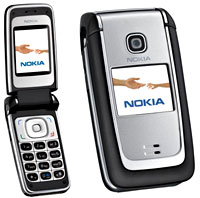 The quadband Nokia 6125 operates in GSM 850/900/1800/1900 networks and provides a flight mode, which enables the user to work with calendar or listen to music while on the flight – although we’ve heard of airlines like Virgin insisting that you turn off all phones – including those with ‘flight modes.’
The quadband Nokia 6125 operates in GSM 850/900/1800/1900 networks and provides a flight mode, which enables the user to work with calendar or listen to music while on the flight – although we’ve heard of airlines like Virgin insisting that you turn off all phones – including those with ‘flight modes.’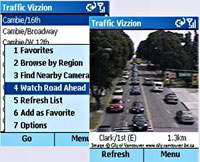 US firm Vizzion have announced the introduction of their innovative traffic-watching system “Traffic Vizzion” to eleven areas in the UK.
US firm Vizzion have announced the introduction of their innovative traffic-watching system “Traffic Vizzion” to eleven areas in the UK.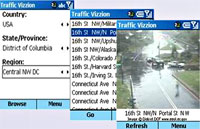 GPS users can also call up a “Find Nearby Cameras” function to list cameras close to their current location, and then select and view any camera from the list in the hope of finding the best way out of a jam.
GPS users can also call up a “Find Nearby Cameras” function to list cameras close to their current location, and then select and view any camera from the list in the hope of finding the best way out of a jam. Traffic Vizzion runs on Windows Mobile 2003 for Smartphones, and relies on a working Internet connection (e.g. GPRS), with a Bluetooth GPS device required for the added features.
Traffic Vizzion runs on Windows Mobile 2003 for Smartphones, and relies on a working Internet connection (e.g. GPRS), with a Bluetooth GPS device required for the added features. A new UK survey shows a dramatic increase in the use of picture messaging with WAP also growing in popularity.
A new UK survey shows a dramatic increase in the use of picture messaging with WAP also growing in popularity. When it comes to seeking mobile information online, it’s the geezers who are keenest to get their keypads rattling, with 38% accessing mobile Internet (WAP) sites compared to 26% of ladies.
When it comes to seeking mobile information online, it’s the geezers who are keenest to get their keypads rattling, with 38% accessing mobile Internet (WAP) sites compared to 26% of ladies.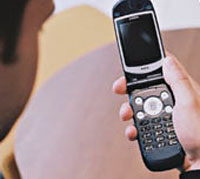 Elsewhere, the Mobile Data Association have calculated that WAP page impressions are now approaching the 2 billion per month mark, with the Mobile Media Monitor revealing the most popular types of site on the mobile internet.
Elsewhere, the Mobile Data Association have calculated that WAP page impressions are now approaching the 2 billion per month mark, with the Mobile Media Monitor revealing the most popular types of site on the mobile internet.